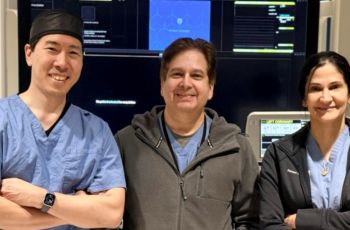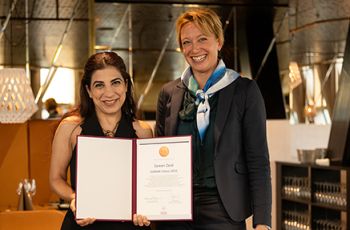As the academic year kicks off, GW’s incoming first-year medical students are gearing up for a rigorous academic experience. This year, the experience will be a bit different than in years past, as the curriculum for the M.D. program at the School of Medicine and Health Sciences (SMHS) has been revised to teach students important skills to help them meet the needs of a changing health care environment.
The revisions to the curriculum are focused on four major areas, including: curriculum delivery, early clinical exposure, important new content areas of study, and enhanced use of technology. These curricular modifications are guided by changes in the health care landscape and informed by research into how medical students learn best.
“SMHS has worked to create an environment that is tailored to optimal learning for its medical students,” said Matthew Mintz, M.D., interim assistant dean for M.D. program curriculum. “While we have a deep tradition of training highly-skilled doctors, we believe these revisions will further enhance the success of our graduates.”
The traditional medical school curriculum, which is more than 100 years old, includes two years of classroom study of topics such as anatomy and biochemistry, followed by two years of clinical work in the hospital. This curriculum strategy has served the medical community well for generations, but in today’s environment of enhanced technology and emphasis on interprofessional practice, adjustment is necessary.
First, GW has integrated its curriculum into organ-based systems and has moved away from lecture-based learning. SMHS is also employing active-learning teaching methods to ensure that GW’s medical students are fully grasping the information they need.
Second, GW medical students will have earlier clinical exposure. Clinical exposure will begin in March of the second year of medical school, giving students earlier experiences with direct care for patients. The increased clinical exposure will allow for students to explore different areas of medicine to better inform their career choices.
Third, GW has introduced important new content areas to the curriculum. With the implementation of the Affordable Care Act, tomorrow’s physician leaders will not only need to know the concepts of anatomy, physiology, and surgery, but will also need to know how to work in a team and understand public policy. The new content areas that GW’s medical students are learning include public health, health policy, topics related to diversity, and interprofessional education. Furthermore, there is additional emphasis on professional development in the areas of wellness, ethics, leadership, and team work.
Lastly, technological advances are assisting in medical care and in medical education. GW has unique and high-tech resources, including a brand new, state-of-the-art Clinical Learning and Simulation Skills Center, which is central to the curriculum. Additionally, each incoming medical student - as well as the current 2nd year medical students - will be issued an iPad, with an array of applications that will help medical students learn and understand important topics.
“Health care is continuously evolving and with the dramatic shift in medicine and medical education, it is important for our school to support innovation in medical education and remain on the cutting-edge,” said Jeffrey S. Akman, M.D., Walter A. Bloedorn Professor of Administrative Medicine, vice president for health affairs, and dean of SMHS. “Thanks to a dedicated group of students, faculty, and staff, we have been able to implement innovative learning and teaching tactics that assist us as we prepare our students to practice medicine in tomorrow’s health care system,” he said.
These tactics, coupled with enhanced faculty development efforts have created a learning environment that is ideal for the modern student and competitive in the market.



